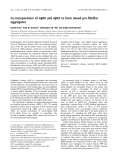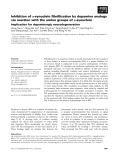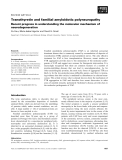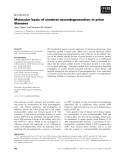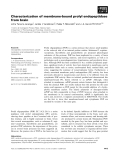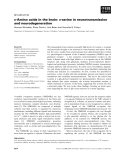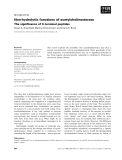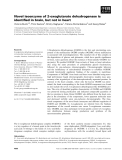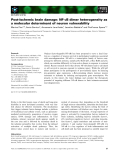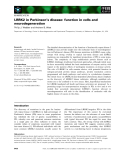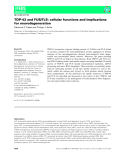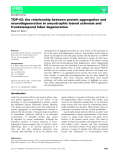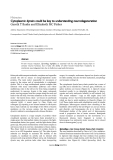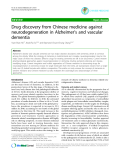
Neurodegeneration
-
Senile plaques, the invariable hallmark and likely proximal cause of Alzheimer’s disease (AD), are structured deposi-tions of the 40- and 42-residue forms of the Abpeptide. Conversely, diffuse plaques, which are not associated with neurodegeneration, consist mainly of unstructured Ab42. We have investigated the interaction between Ab40 and Ab42 through an assay, which involves labeling both vari-ants with an environment-sensitive fluorophore.
 10p
10p  tumor12
tumor12
 20-04-2013
20-04-2013
 28
28
 2
2
 Download
Download
-
Fibrillization ofa-synuclein (a-Syn) is closely associated with the formation of Lewy bodies in neurons and dopamine (DA) is a potent inhibitor for the process, which is implicated in the causative pathogenesis of Parkin-son’s disease (PD). To elucidate any molecular mechanism that may have biological relevance, we tested the inhibitory abilities of DA and several analogs including chemically synthetic and natural polyphenols in vitro.
 12p
12p  fptmusic
fptmusic
 11-04-2013
11-04-2013
 44
44
 2
2
 Download
Download
-
Neurodegenerative disorders, such as Huntington’s, Alzheimer’s, and Parkinson’s diseases, affect millions of people worldwide and currently there are few effective treatments and no cures for these diseases. Transgenic mice expressing human transgenes for huntingtin, amyloid precursor protein, and other genes associated with familial forms of neurodegenerative disease in humans provide remarkable tools for studying neurodegeneration because they mimic many of the pathological and behavioural features of the human conditions. ...
 15p
15p  awards
awards
 06-04-2013
06-04-2013
 39
39
 4
4
 Download
Download
-
Familial amyloidotic polyneuropathy (FAP) is an inherited autosomal dominant disease that is commonly caused by accumulation of deposits of transthyretin (TTR) amyloid around peripheral nerves. The only effective treatment for FAP is liver transplantation.
 14p
14p  galaxyss3
galaxyss3
 21-03-2013
21-03-2013
 53
53
 2
2
 Download
Download
-
The biochemical nature and the replication of infectious prions have been intensively studied in recent years. Much less is known about the cellular events underlying neuronal dysfunction and cell death. As the cellular func-tion of the normal cellular isoform of prion protein is not exactly known, the impact of gain of toxic function or loss of function, or a combination of both, in prion pathology is still controversial.
 6p
6p  galaxyss3
galaxyss3
 21-03-2013
21-03-2013
 62
62
 5
5
 Download
Download
-
Prolyl oligopeptidase (POP) is a serine protease that cleaves small peptides at the carboxyl side of an internal proline residue. Substance P, arginine– vasopressin, thyroliberin and gonadoliberin are proposed physiological substrates of this protease. POP has been implicated in a variety of brain processes, including learning, memory, and mood regulation, as well as in pathologies such as neurodegeneration, hypertension, and psychiatric disor-ders.
 13p
13p  galaxyss3
galaxyss3
 07-03-2013
07-03-2013
 40
40
 3
3
 Download
Download
-
The mammalian brain contains unusually high levels ofd-serine, ad-amino acid previously thought to be restricted to some bacteria and insects. In the last few years, studies from several groups have demonstrated that d-serine is a physiological co-agonist of the N-methyl d-aspartate (NMDA) type of glutamate receptor – a key excitatory neurotransmitter receptor in the brain.
 13p
13p  galaxyss3
galaxyss3
 07-03-2013
07-03-2013
 45
45
 3
3
 Download
Download
-
Amyloid-b(Ab) aggregation and amyloid formation are key pathological features of Alzheimer’s disease, and are considered to be two of the major contributing factors to neurodegeneration and dementia. Identification of small molecule inhibitors that are orally available, have low toxicity and high central nervous system bioavailability is one approach to the potential development of a disease-modifying treatment for Alzheimer’s disease.
 12p
12p  media19
media19
 06-03-2013
06-03-2013
 49
49
 2
2
 Download
Download
-
This review explores the possibility that acetylcholinesterase may play a pivotal, non-hydrolytic role in neurodegeneration. More specifically, C-ter-minal sequences of acetylcholinesterase may act as signalling molecules in key brain regions characteristically vulnerable to Alzheimer’s, Parkinson’s and motor neuron disease.
 8p
8p  media19
media19
 05-03-2013
05-03-2013
 28
28
 3
3
 Download
Download
-
Alzheimer’s disease (AD) is a neurological disorder characterized by the presence of amyloidb(Ab) peptide fibrils and oligomers in the brain. It has been suggested that soluble Ab oligomers, rather than Ab fibrils, contribute to neurodegeneration and dementia due to their higher level of toxicity.
 12p
12p  vinaphone15
vinaphone15
 28-02-2013
28-02-2013
 34
34
 2
2
 Download
Download
-
2-Oxoglutarate dehydrogenase (OGDH) is the first and rate-limiting com-ponent of the multienzyme OGDH complex (OGDHC) whose malfunction is associated with neurodegeneration. The essential role of this complex in the degradation of glucose and glutamate, which have specific significance in brain, raises questions about the existence of brain-specific OGDHC iso-enzyme(s).
 17p
17p  vinaphone15
vinaphone15
 28-02-2013
28-02-2013
 35
35
 2
2
 Download
Download
-
Nuclear factor-kappaB (NF-jB) has been proposed to serve a dual func-tion as a regulator of neuron survival in pathological conditions associated with neurodegeneration. NF-jB is a transcription family of factors com-prising five different proteins, namely p50, RelA⁄p65, c-Rel, RelB and p52, which can combine differently to form active dimers in response to external stimuli.
 9p
9p  vinaphone15
vinaphone15
 27-02-2013
27-02-2013
 26
26
 3
3
 Download
Download
-
The detailed characterization of the function of leucine-rich repeat kinase 2 (LRRK2) may provide insight into the molecular basis of neurodegenera-tion in Parkinson’s disease (PD) because mutations in LRRK2 cause a phe-notype with strong overlap to typical late-onset disease and LRRK2 mutations are responsible for significant proportions of PD in some popu-lations.
 9p
9p  viettel02
viettel02
 20-02-2013
20-02-2013
 26
26
 4
4
 Download
Download
-
TDP-43 (transactive response binding protein of 43 kDa) and FUS (fused in sarcoma) comprise the neuropathological protein aggregates of distinct subtypes of the neurodegenerative diseases frontotemporal lobar degen-eration and amyotrophic lateral sclerosis.
 19p
19p  cosis54
cosis54
 09-12-2012
09-12-2012
 58
58
 4
4
 Download
Download
-
Accumulations of aggregated proteins are a key feature of the pathology of all of the major neurodegenerative diseases. Amyotrophic lateral sclerosis (ALS) was brought into this fold quite recently with the discovery of TDP-43 (TAR DNA binding protein, 43 kDa) inclusions in nearly all ALS cases.
 11p
11p  cosis54
cosis54
 09-12-2012
09-12-2012
 49
49
 3
3
 Download
Download
-
Tuyển tập các báo cáo nghiên cứu về y học được đăng trên tạp chí y học Critical Care giúp cho các bạn có thêm kiến thức về ngành y học đề tài: Cytoplasmic dynein could be key to understanding neurodegeneration...
 4p
4p  coxanh_8
coxanh_8
 05-11-2011
05-11-2011
 37
37
 1
1
 Download
Download
-
Tuyển tập các báo cáo nghiên cứu về y học được đăng trên tạp chí y học Critical Care giúp cho các bạn có thêm kiến thức về ngành y học đề tài: rug discovery from Chinese medicine against neurodegeneration in Alzheimer’s and vascular dementia...
 6p
6p  coxanh_5
coxanh_5
 28-10-2011
28-10-2011
 44
44
 4
4
 Download
Download
CHỦ ĐỀ BẠN MUỐN TÌM








